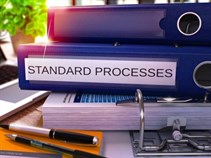A Complete Guide to Effective Business Writing
Effective business writing is one of the most important, though often overlooked, skills that anyone can learn. In addition to improving your team’s overall communication, knowing how to properly write various business documents from the simple (such as emails and newsletters) to the complex (deviation reports and SOPs) profoundly impacts profitability and customer satisfaction.
We’ve compiled business writing tips from experts with decades of experience in their respective fields to help kickstart your team’s writing journey to more effective business documents.
This business writing guide dives into each of the following:
- The Value of Communication Through Effective Business Writing
- Types of Business Writing
- Styles of Business Writing
- Getting to the Point: Business Writing Tips
- Putting it all Together
- Business Writing FAQs
1. The Value of Communication Through Effective Business Writing
Effective business writing skills are critically important to the health of every company. Being able to convey the right information, in the right way can make a difference in a business’ success. To that point, every company has a responsibility to:
- Communicate with clients or customers
- Present their brand and expertise using consistent language
- Describe its services in a way that invites and engages consumers
- Clearly articulate messaging to prevent misunderstandings
A breakdown at any of these points can lead to problems that affect operations, culture, customer service, sales and marketing, and, ultimately, profitability. These consequences of poor business writing can not only hurt teams, but also sink an entire business. That’s why effective business writing is so important for success.
Help your team write more effective documents in less time!SEE COURSE DESCRIPTION
Consider these areas of business writing, how your company uses them, and if changes need to be made:
- Your Internet Face
No matter how much the grammar police may cringe over internet slang, the web has turned writing into a hugely important part of branding. If your website doesn’t have information that readers can skim to get what they need, if your Twitter feed sounds robotic (or doesn’t exist at all), or if your email campaigns don’t speak to the reader, your overall brand can suffer. - Employee and Consumer Time
Unclear writing means time spent double-checking facts, getting clarification, acting on wrong assumptions and, for customers, it may mean getting frustrated and abandoning your site altogether. Brushing up on business writing skills ensures that your meaning always comes through clearly to mitigate these risks. - Connecting With Your Niche
No matter what services you offer, your target audience is at least some degree more specific than “everyone.” But how do your customers find you? And once they’ve found you, how do they become confident that your services are the services they’re looking for? Strong business writing communication skills can be the difference between a customer initiating contact and deciding to try somewhere else.
Regardless of which area you choose to focus on, knowing the different types of business writing, the styles that can be used in each area, and the business writing strategies to employ will help your teams effectively improve their work, and that of the company as a whole.
2. Types of Business Writing
Understanding the types of business writing that your company should be using and how to use them are the first big steps towards aligning expectations, eliminating confusion, and increasing success. While there are many, many types of business writing, we’ll cover the most important and most often used examples.
Most readers decide to keep reading in six seconds.
Make them count with Hurley Write Better Business Writing training.
Take the Team Course Take the Individual Course
Internal Types of Business Writing
Business writing documents that are internal facing are meant for employees only, which means that there may be sensitive information or restrictions on who is privy. Keep in mind who your audience is (mass communication to all employees? C-Suite execs only?) so you can tailor your writing appropriately.
- Memos
Memos are designed to communicate to everyone in a company (One-to-All) or everyone within a department (One-to-Many). They are an effective tool wielded by leadership to explain a big change, remind employees of company policy, or provide specific information. Memos are short, high-level overviews with a professional tone, but writing an effective memo requires forethought and structure. - Executive Summary
Executive summaries are short recaps of either an in-depth research report or a large document filled with tons of details. The purpose of this business writing document is to provide a high-level overview of the document so that the busy decision-maker can easily figure out the issue is, why it’s an issue, and what needs to be done.Since most executives don’t have time to dive into details (that’s what the report is for!), the executive summary serves as a short but sweet document that helps the reader make quick and decisive actions.Does your team need help writing effective executive summaries? Consider one of our onsite or virtual workshops.
- Handbooks/User Manual
Employee handbooks and user manuals are technical informational resources that employees or customers use to figure out a process, troubleshoot, or understand how something works or why it’s important. They ensure employees adhere to a consistent process for frequent or complex tasks and that customers have the information they need.Did you know that poorly written user manuals cost companies both time and money? Consider a technical course to improve your team’s user manuals.
View Course Details - Standard Operating Procedures (SOPs)
SOPs are one of the most valuable types of business writing documents that a company can have on hand. They provide standardization for processes and procedures so that any employee accessing them can read, understand, and follow-through in a uniform manner.If your team needs pointers on writing better SOPs, take a look at our free guide, How to Write an SOP: Consider Work Instructions for Consistent Outcomes. Ready for your team to write more effective SOPs? Sign up for our SOP course today.
See Course Details
External Types of Business Writing
External facing business documents are those communications meant to inform, entertain, create conversations, and nurture relationships with anyone outside of your organization whether it be customers, potential clients, investors, or business partners.
- Press Releases
The most formal of external business communications are press releases. Intended solely to inform via an announcement, these business writing documents maintain a professional tone and are usually written for other businesses. They are succinct and to the point. - Social Media
Writing for social media is most often friendly and informal. This medium is meant to start a conversation with customers, nurture existing relationships, promote culture, inform your customer base of new products and changes, entertain, and more.Though seemingly straightforward, many writers don’t know how to write effective social media posts. If this sounds like your company, look into taking advantage of formal training, such as with our collaborative and interactive workshop.
Hybrid Types of Business Writing
Communications that don’t strictly fall into the either/or are considered a hybrid, meaning that they can be sent either internally or externally. Depending on who your reader is, these can range from formal to informal.
- Emails
As you craft an email, knowing effective business writing tips can be the difference between a timely response with the information you need and an email that’s ignored because it frustrates your reader. - Newsletters
The best newsletters serve as a high-level informational resource that points readers to more detailed information, whether it be blogs, videos, websites, social media, or another piece of content. - Reports
Largely considered one of the more difficult types of business writing to master, reports walk a tricky line: they must be detailed enough to deliver the full picture accurately while also being succinct enough to not bore the reader.While technical and scientific teams do most of this kind of business writing, knowing how to write an effective report is essential for business people of all backgrounds.We offer standardized training for many types of report writing, including - For details on these classes, click the link.
Using the correct communication style will help your team become more effective writers with communication skills that produce better results.
3. Styles of Business Writing
Effective communication skills lead to more efficient professional and business writing. It sounds simple but effective communication is more than just articulating something well. The best communication uses a tailored tone and a writing style that supports the purpose of the message or goal. Here are the different styles of written communication you should know:
- Results-Oriented Communication
Best used for interoffice correspondence, results-oriented communication is a less formal (though not completely informal) way of asking for specific information. It’s brief, concise, and to the point. Results-oriented communication should use an active voice and compel the audience to take action, like meeting certain requirements or standards, reporting findings, and more. - Informational Communication
Some styles of business writing are meant to deliver vital instructions, data, intelligence, or findings. This type of writing especially relies on clarity and conciseness. - Persuasive Communication
Persuasive business writing appeals to emotion and uses strong language to incite a response. Therefore, your writing must be a balance of logical reasoning and clear objectives. When leveraging the power of persuasive communication, you must consider the reader’s opinion, the action you want the reader to take, and what objections the reader may raise. Remember, your audience is most interested in how the communication affects them. - Negative Communication
Sometimes businesses have to deliver bad news, give reason for taking an unpopular action, or provide critical/constructive feedback. In these situations, more formal language (though without coming off as unsympathetic) while being tactful is recommended to avoid alienating the reader.We recommend the “sandwich” business writing technique:- Begin with a sincere positive statement;
- Follow with the negative information (phrased positively, if possible); and
- End with positive statement
Knowing these styles, paired with knowledge of the different types of business writing, are foundational to crafting intentional and effective business communications.
4. Getting to the Point: Business Writing Tips
Though they may seem obvious at first glance, these business writing tips seek to overturn these common bad habits. Traditional schooling often assigned writing with word count requirements, which habituated fillers and rambling to help us reach our magic 1,500 words, where we called it good.
But good business writing demands the opposite. Padding your message with unnecessary words doesn’t make you sound more intelligent or impressive, it just makes it more difficult for readers to get your message.
- Keep it short, sweet, and get to the point.
Dropping the verbosity habit can be difficult but will have immediate and positive effects on your business writing. Read the following sample passage:At this point in time, our estimated date for this extremely important and necessary task is currently three months from today. If there is the slightest possibility of any sort of delay, our clients will be notified in the most timely fashion.You probably understood the point of this message, as it’s grammatically correct and full of A-level words. But as a client, wouldn’t you rather read this instead?Our estimated completion date is June 15. We’ll be sure to notify you of any potential delays.Half the words CAN retain all the meaning. If anything, the second sample is more precise, giving an exact delivery date. It’s more engaging, addressing the reader as “you” instead of the more impersonal “our clients.” And it takes half the time to read and digest.Email communication is a great example. Well-written emails concisely state the purpose or request for action first and supporting details follow. It’s an all too common mistake that leads to miscommunication and time lost. Next time you author an email, ask, “Why am I writing this?” The answer should be in the first line or, even better, in the subject line. - Take the Simplest Route
Want to see rapid improvements in your business writing? Use these three business writing tips immediately and often:- Take the Simplest Route
Weed out words such as “very,” “so,” and “really” — they’re vague and rarely add quality. Instead, look for more descriptive words that add value but would also be understood by most, if not all, readers. - Get active.
In most business writing situations, using active voice is best because it moves the narrative at a faster and more engaging pace than passive voice. Passive tense also lends itself to more grammatical mistakes and less clear meaning. Consider the following example:Active: “The man took his cat to the vet.”
Passive: “The cat was taken to the vet by the man.” - Adopt minimalist principles.
Avoid a phrase when a word will do. The worst offenders?- “As a matter of fact…”
- “In fact…”
- “In my opinion…”
- “In order to…”
- Take the Simplest Route
- Avoid Interpretive Words
“The very low quantity” and “a small amount of time” leave room for misinterpretation, as “very,” “low,” and “small” are interpretive, which means they can be defined differently, depending on the reader.If a word can’t be quantified, or if everyone can’t agree about what it means, leave it out. Using interpretive words cloud your meaning. - Clarify a Call to Action
Why are you writing? What action is the reader supposed to take after reading the document? By giving the reader a clear direction of what they should do, you’ll be able to measure the effectiveness of your business writing and define the overall purpose of your communication. - Answer the Five Ws
Often, the action that the reader is supposed to take must be stated specifically. To make your messages clearer, tell the reader:- Who should act
- What they should do
- Where they can take the action
- When the action should be performed, and
- Why they should do it
The next step in the business writing journey is to edit your document, which ideally should be done during the writing process (without wordsmithing to the point of procrastination!). Read on for some quick business writing tips when editing.


